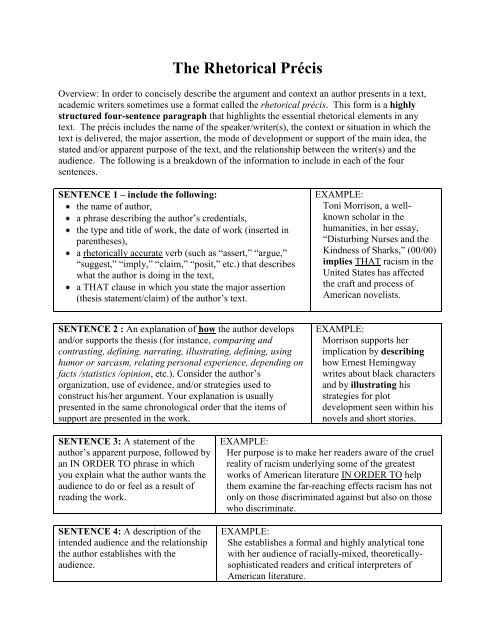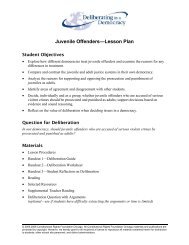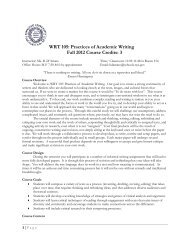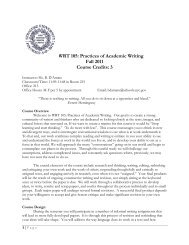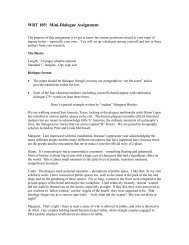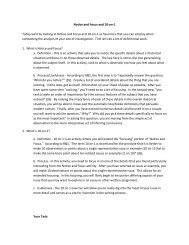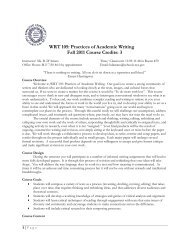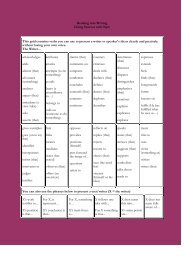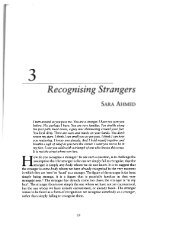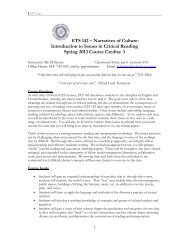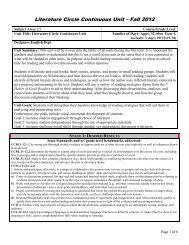The Rhetorical Précis - Litstudies.org
The Rhetorical Précis - Litstudies.org
The Rhetorical Précis - Litstudies.org
You also want an ePaper? Increase the reach of your titles
YUMPU automatically turns print PDFs into web optimized ePapers that Google loves.
<strong>The</strong> <strong>Rhetorical</strong> <strong>Précis</strong><br />
Overview: In order to concisely describe the argument and context an author presents in a text,<br />
academic writers sometimes use a format called the rhetorical précis. This form is a highly<br />
structured four-sentence paragraph that highlights the essential rhetorical elements in any<br />
text. <strong>The</strong> précis includes the name of the speaker/writer(s), the context or situation in which the<br />
text is delivered, the major assertion, the mode of development or support of the main idea, the<br />
stated and/or apparent purpose of the text, and the relationship between the writer(s) and the<br />
audience. <strong>The</strong> following is a breakdown of the information to include in each of the four<br />
sentences.<br />
SENTENCE 1 – include the following:<br />
the name of author,<br />
a phrase describing the author’s credentials,<br />
the type and title of work, the date of work (inserted in<br />
parentheses),<br />
a rhetorically accurate verb (such as “assert,” “argue,”<br />
“suggest,” “imply,” “claim,” “posit,” etc.) that describes<br />
what the author is doing in the text,<br />
a THAT clause in which you state the major assertion<br />
(thesis statement/claim) of the author’s text.<br />
SENTENCE 2 : An explanation of how the author develops<br />
and/or supports the thesis (for instance, comparing and<br />
contrasting, defining, narrating, illustrating, defining, using<br />
humor or sarcasm, relating personal experience, depending on<br />
facts /statistics /opinion, etc.). Consider the author’s<br />
<strong>org</strong>anization, use of evidence, and/or strategies used to<br />
construct his/her argument. Your explanation is usually<br />
presented in the same chronological order that the items of<br />
support are presented in the work.<br />
SENTENCE 3: A statement of the<br />
author’s apparent purpose, followed by<br />
an IN ORDER TO phrase in which<br />
you explain what the author wants the<br />
audience to do or feel as a result of<br />
reading the work.<br />
SENTENCE 4: A description of the<br />
intended audience and the relationship<br />
the author establishes with the<br />
audience.<br />
EXAMPLE:<br />
Toni Morrison, a wellknown<br />
scholar in the<br />
humanities, in her essay,<br />
“Disturbing Nurses and the<br />
Kindness of Sharks,” (00/00)<br />
implies THAT racism in the<br />
United States has affected<br />
the craft and process of<br />
American novelists.<br />
EXAMPLE:<br />
Morrison supports her<br />
implication by describing<br />
how Ernest Hemingway<br />
writes about black characters<br />
and by illustrating his<br />
strategies for plot<br />
development seen within his<br />
novels and short stories.<br />
EXAMPLE:<br />
Her purpose is to make her readers aware of the cruel<br />
reality of racism underlying some of the greatest<br />
works of American literature IN ORDER TO help<br />
them examine the far-reaching effects racism has not<br />
only on those discriminated against but also on those<br />
who discriminate.<br />
EXAMPLE:<br />
She establishes a formal and highly analytical tone<br />
with her audience of racially-mixed, theoreticallysophisticated<br />
readers and critical interpreters of<br />
American literature.
Templates for the <strong>Rhetorical</strong> <strong>Précis</strong><br />
Provided below are three templates you can refer to when using the rhetorical précis form. You<br />
should use these for guidance, but use your best judgment about how to form sentences<br />
appropriate to the text and/or author you write about.<br />
1. (Author’s credentials), (author’s first and last name), in his/her (type of text), (title of text),<br />
published in (publishing info), addresses the topic of (topic of text) and argues that (argument).<br />
2. S/he supports this claim by___________, then___________, and finally____________.<br />
3. (Author’s last name)’s purpose is to (author’s purpose in writing) in order to (change in<br />
reader/society the author wants to achieve).<br />
4. He/she adopts a(n) __________ tone for his/her audience, the readers of (publication) and<br />
others interested in the topic of______________.<br />
1. In the (type of text), (title of text) ((year)), author (author’s first and last name), (author’s<br />
credentials), asserts that (argument) and suggests (explanation of sub-claims or resolution).<br />
2. S/he backs up this claim by doing the following: first, s/he ; next, s/he<br />
; last, s/he .<br />
3. (Author’s last name) appears to write in hopes of (author’s purpose in writing) in order to<br />
(change in reader/society the author wants to achieve.<br />
4. Because of the author’s tone, it seems as if s/he writes for a and<br />
audience.<br />
1. In his/her (type of text) (title of text) ((year)), (author’s credentials) (author’s first and last name)<br />
asserts that (argument) by addressing , , and .<br />
2. By supplying the reader with information about and , (author’s last<br />
name) builds his/her claims about .<br />
3. (Author’s name) wishes to convey to readers the importance of (author’s purpose in writing) in<br />
order to (change in reader/society the author wants to achieve).<br />
4. <strong>The</strong> author’s audience likely consists of those interested in as is evident<br />
through his/her references to and ; s/he addresses readers with a tone<br />
that is and .


